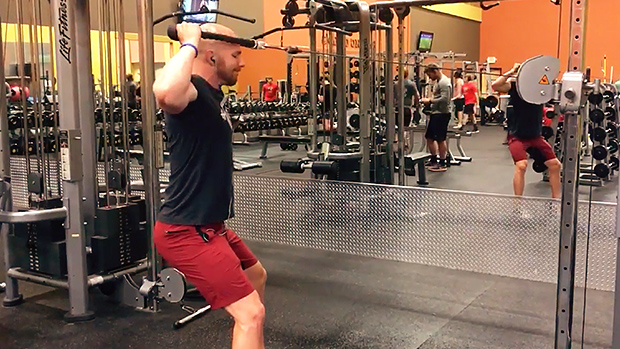Most lifters gauge someone's strength by how much they bench or squat. But why doesn't controlling our own bodyweight come to mind as a strength benchmark? Maybe it's time it did.
Enter the pike push-up. This is a phenomenal exercise as a stand-alone strength movement or as a finisher if you're looking to torch your delts, triceps, and upper traps for a few sets to failure.
1. Get in the right starting position:
- Place your hands on the floor, roughly outside shoulder width, and fingers facing straight ahead.
- Fully extend your arms directly overhead. There must be no bend at the knee, and you must achieve approximately 90 degrees of hip flexion.
- From there, your goal is to turn your body into an upside-down letter V – the pike position.
- Bring your feet in towards your hands, lifting your butt to the ceiling. You'll want to put as much of your weight into your hands as possible from this position. To do that, you'll be pivoting on the balls of your feet as you work through the complete range of motion.
- Tightness in either the hamstrings or the lower back will make it necessary to widen the distance between your feet to allow your knees to fully lock out.
2. Starting at the top of the movement with arms fully extended, here's what to do:
- Begin to bend your elbows. Keep them roughly in profile with your body while keeping your shoulders pulled back. Maintain a neutral neck position and thoracic spine extension.
- Continue to let your elbows bend as you lower the top of your head to the floor. Rock further onto your toes to help ensure a smooth descent and proper weight distribution.
- Let your head lightly make contact with the floor, then push through the heel and outer edge of your hand, driving yourself up and away as you rock back to the balls of your feet.
- Maintain the pike position, demonstrating thoracic extension and straight legs.
Modify it with this wide-stance regression:
If the mobility of your hamstrings is the main issue, a wider stance will help you get your legs fully extended and keep the weight distributed into your hands, arms, and shoulders.
Wider hand placement will also lead to a shorter range of motion and a lesser degree of stretch for the press, allowing it to be regressed further.
Here's a box regression:
If you have a short box, stool, or chair available, a kneeling approach on the box can get you into a similar inverted position, which eliminates tight hamstrings from being a factor just as well.
Here's a box progression:
If you're able to complete a set of 10-12 unbroken reps of the standard variation, try this progression. Just elevate your feet while still maintaining the pike position.
Elevating your feet will add more weight to your press and place a greater amount of your body above your hands. The box also helps to get you into an even greater vertical position, which makes you work more directly against gravity.
If you're more advanced, try the strict handstand push-up:
Only do this if you're able to do a set of 10-12 reps with feet elevated on a box.
Using a wall for balance, place your hands roughly 10 inches off the wall and kick yourself up to the top. It's important to be in control of the lowering or eccentric movement since you're at greater risk of a neck injury if you can't control your descent.





